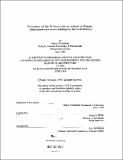| dc.contributor.author | Tornikidis, Nikos | en_US |
| dc.contributor.other | Massachusetts Institute of Technology. Dept. of Architecture. | en_US |
| dc.coverage.spatial | e-xr--- | en_US |
| dc.date.accessioned | 2012-04-26T18:24:49Z | |
| dc.date.available | 2012-04-26T18:24:49Z | |
| dc.date.copyright | 1993 | en_US |
| dc.date.issued | 1993 | en_US |
| dc.identifier.uri | http://hdl.handle.net/1721.1/70224 | |
| dc.description | Thesis (M. Arch.)--Massachusetts Institute of Technology, Dept. of Architecture, 1993. | en_US |
| dc.description | Includes bibliographical references (p. 71). | en_US |
| dc.description.abstract | The project of the following design thesis attempted to address some Industrial Design issues (or in this particular case with the design in a semi-industrial environment - railway station) and how such an approach can be incorporated into a city tissue which follows a different pattern of behavior, formally and functionally. An issue that could be looked upon is how the two different, but in this case related, functional areas could coexist, making a railway station part of a city, as it was until the beginning of the 20th century when the notion of mass production was introduced. There are, however, two ways the problem of connecting the two separate entities can be looked upon, which are also identical with the two parts that could be followed when attempting to find a solution. The first part, which is the part attempted to be solved in this project, has to do with the internal problems of the site (station area), how these problems are identified accordingly to the impact the city has on the site, and what solutions can be proposed in order the station to function more as a part of the city than as an entity of its own. After the completion of the first part, the second part of the problem should examine what impact the proposed intervention should have on the city itself, in order an exchange region to be created between the two entities. It should be added, however, that the two aspects can not be considered separately, and therefore when working on any of the two aspects one should consider the implications his or her decision will have on the following actions. The production process started from manufacture production in the 19th century, when railway stations were a part of cities, played major role in their development, and for the most part were also. constructed. After the Second World War railway stations become "servants" of the adopted mass production process, based on scale economies and resource allocation. Their scale changes and the behavior towards the cities that by then surrounded them had become more alien. After the 1980s, however, the new concepts of lean production, flexibility and differentiation brought back some of the characteristic of the manufacture era. Those characteristics are smaller, diversified facilities, tightly related to a particular region and easily adaptable to changes in the environment. | en_US |
| dc.description.statementofresponsibility | by Nikos Tornikidis. | en_US |
| dc.format.extent | 71 p. (some folded) | en_US |
| dc.language.iso | eng | en_US |
| dc.publisher | Massachusetts Institute of Technology | en_US |
| dc.rights | M.I.T. theses are protected by
copyright. They may be viewed from this source for any purpose, but
reproduction or distribution in any format is prohibited without written
permission. See provided URL for inquiries about permission. | en_US |
| dc.rights.uri | http://dspace.mit.edu/handle/1721.1/7582 | en_US |
| dc.subject | Architecture. | en_US |
| dc.title | Extension of the Wilson railway station in Prague : administration and service buildings for the Czech railways | en_US |
| dc.type | Thesis | en_US |
| dc.description.degree | M.Arch. | en_US |
| dc.contributor.department | Massachusetts Institute of Technology. Department of Architecture | |
| dc.identifier.oclc | 28737975 | en_US |
